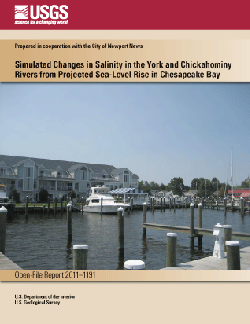Open-File Report 2011–1191

ABSTRACTAs a result of climate change and variability, sea level is rising throughout the world, but the rate along the east coast of the United States is higher than the global mean rate. The U.S. Geological Survey, in cooperation with the City of Newport News, Virginia, conducted a study to evaluate the effects of possible future sea-level rise on the salinity front in two tributaries to Chesapeake Bay, the York River, and the Chickahominy/James River estuaries. Numerical modeling was used to represent sea-level rise and the resulting hydrologic effects. Estuarine models for the two tributaries were developed and model simulations were made by use of the Three-Dimensional Hydrodynamic-Eutrophication Model (HEM-3D), developed by the Virginia Institute of Marine Science. HEM-3D was used to simulate tides, tidal currents, and salinity for Chesapeake Bay, the York River and the Chickahominy/James River. The three sea-level rise scenarios that were evaluated showed an increase of 30, 50, and 100 centimeters (cm). Model results for both estuaries indicated that high freshwater river flow was effective in pushing the salinity back toward Chesapeake Bay. Model results indicated that increases in mean salinity will greatly alter the existing water-quality gradients between brackish water and freshwater. This will be particularly important for the freshwater part of the Chickahominy River, where a drinking-water-supply intake for the City of Newport News is located. Significant changes in the salinity gradients for the York River and Chickahominy/James River estuaries were predicted for the three sea-level rise scenarios. When a 50-cm sea-level rise scenario on the York River during a typical year (2005) was used, the model simulation showed a salinity of 15 parts per thousand (ppt) at river kilometer (km) 39. During a dry year (2002), the same salinity (15 ppt) was simulated at river km 45, which means that saltwater was shown to migrate 6 km farther upstream during a dry year than a typical year. The same was true of the Chickahominy River for a 50-cm sea-level rise scenario but to a greater extent; a salinity of 4 ppt was simulated at river km 13 during a typical year and at river km 28 during a dry year, indicating that saltwater migrated 15 km farther upstream during a dry year. Near a drinking-water intake on the Chickahominy River, for a dry year, salinity is predicted to more than double for all three sea-level rise scenarios, relative to a typical year. During a typical year at this location, salinity is predicted to increase to 0.006, 0.07, and more than 2 ppt for the 30-, 50-, and 100-cm rise scenarios, respectively. |
First posted September 22, 2011 For additional information contact: Part or all of this report is presented in Portable Document Format (PDF); the latest version of Adobe Reader or similar software is required to view it. Download the latest version of Adobe Reader, free of charge. |
Rice, K.C., Bennett, M.R., and Shen, Jian, 2011, Simulated changes in salinity in the York and Chickahominy Rivers from projected sea-level rise in Chesapeake Bay: U.S. Geological Survey Open-File Report 2011–1191, 31 p.
Abstract
Introduction
Climate Variability and Change and Sea-Level Rise
Drinking-Water Utilities and Climate Change
Study Area
Sea-Level Rise in Chesapeake Bay
Sea-Level Rise Scenarios
Hydrodynamic Models
Model Limitations
York River Model
Chickahominy River Model
Model Results
York River
Chickahominy River
Summary
Acknowledgments
References
Appendix